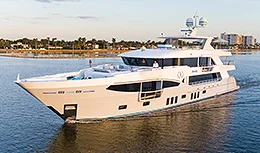- Alaskan Yachts
- Azimut Yachts
- Back Cove Yachts
- Beneteau Yachts
- Benetti Superyachts
- Bertram Yachts
- Boston Whaler
- Broward Yachts
- Buddy Davis Sportfish
- Burger Yachts
- Cabo Yachts
- Catamarans
- Carver Motoryachts
- Center Console
- Chris-Craft Yachts
- Cruisers Yachts
- DeFever Trawlers
- Dufour Sailboats
- Fairline Yachts
- Feadship Yachts
- Ferretti Yachts
- Filippetti Yachts
- Formula Yachts
- Fountaine Pajot Cats
- Grady-White
- Grand Banks Trawlers
- Hargrave Yachts
- Hatteras Yachts
- Hinckley Picnic Boats
- Horizon Yachts
- Hydra-Sports
- Intrepid Boats
- Jarrett Bay Sportfish
- Jeanneau Yachts
- Kadey-Krogen Trawlers
- Lazzara Yachts
- Lekker Boats
- Luhrs Sportfish
- Marlow Yachts
- Maritimo Yachts
- Marquis Yachts
- Mazu Yachts
- McKinna Motoryachts
- Meridian Yachts
- Midnight Express
- MJM Yachts
- Mochi Craft
- Neptunus Motoryachts
- Nordhavn Trawlers
- Nordic Tugs
- Numarine Yachts
- Ocean Alexander Yachts
- Ocean King
- Offshore Yachts
- Outer Reef
- Oyster Sailing Yachts
- Pacific Mariner Yachts
- Palmer Johnson Yachts
![What To Look For During A Sea Trial [Yacht Guide]](https://www.denisonyachtsales.com/wp-content/uploads/2020/11/Seatrial-thumbnail-2.webp)
What To Look For During A Sea Trial [Yacht Guide]
Test run your next new or used boat before purchasing it.
A sea trial is a test run of a yacht or boat that you’re interested in purchasing. It’s a standard part of the boat buying process and an opportunity to observe how your dream yacht or boat cruises on the water. The goal of a sea trial is to conduct a pre-purchase inspection of the boat to observe how the vessel handles and to uncover any flaws or defects in its systems. It’s important to determine if all systems function normally when running under normal conditions.
Just as you might test drive a car before purchasing it, you can do the same with a new or used boat. For first-time yacht owners, it can be confusing to know what to look for during the test run. If that’s the case, bring along your reliable yacht broker, knowledgeable boating friend, or, for larger boats, a marine surveyor as an extra pair of eyes.
While it’s no doubt going to be an exhilarating ride, here’s a quick checklist of what to look for during a sea trial. Remember, your Denison yacht broker will be available to you throughout the entire boat buying process, including yacht showing, sea trial, and boat closing.
Arrive Prepared

As you prepare for your sea trial, make sure to pack a notepad and pen to jot down any observations or questions you may have about the yacht or boat. It may also be handy to bring a camera or use a phone camera for photos. While you’re still tied to the dock, get on board, and conduct a visual inspection of the vessel. Observe the engine and transmission fluids, steering system, and exhaust system. Wiggle any grab rails or seat pedestals to ensure that they’re firmly mounted. Use all of your senses and take your time to see, smell, or touch the boat so you don’t miss anything.
During The Sea Trial

Listen for the engine alarms as you turn the keys or ignition switch to “on” without starting the engine. If you don’t hear anything, the engine may be operating without low oil pressure or high water temperature alarms (that means there’s no warning for an impending overheat). As she gets underway, test visibility as the driver. Do you have good forward vision when accelerating onto plane? Is there a distracting reflection or glare off the windshield? Make note of these observations.
Create or head into rougher water to see how the boat handles bumps. Listen for rattles or vibrations as you speed up and go over wake on open water. A well-designed hull will easily carve through the wake. At no-wake speeds, center the wheel and note how well the boat keeps its line. Does it wander at slow speeds? Single sterndrive or outboard-powered boats have a tendency to drift, but that can be minimized by trimming the engine up slightly.
As a passenger, sit in various seats throughout the boat. If the boat has a forward cockpit, does it offer security to passengers? Is the main cockpit roomy enough for adults? Does the layout encourage socializing or is it ideal for fishing? Make sure that as a passenger underway, you feel comfortable at high speeds without constantly reaching for handholds.
While it’s important to simulate real-world usage during a sea trial, keep in mind that performance may be affected during a lightly loaded test ride. On a typical day that you use the boat, you’re probably going to pack it with coolers, fishing gear, or guests and family members — that weight gives way to a different performance. If the boat feels too sluggish to hit performance targets during the sea trial, ask your broker about other horsepower options available.
Other factors to consider

As you spend time with the new or used boat during a sea trial, check interior items such as stowage, upholstery, handhold and cup holder placements, maneuverability inside the vessel, and electronics. Go ahead and flip on all electrical accessories to confirm they’re working. Don’t forget the running lights and bilge pump. Listen to the boat while underway and make note if you hear anything unusual such as rattles or vibrations.
One of the differences between buying a new boat versus a used boat is power. A benefit of purchasing a new boat is that you can rig it the way you want — so you can request a sea trial on a boat with the same make and model engines as on the boat you want to purchase (if it’s different). For used boats, the power installed is the power you get.
Buying a new or used powerboat, sailboat, catamaran, or center console is an exciting experience. Make sure to get a thorough evaluation of the vessel before purchasing it, that way there are no surprises once it’s in your possession. Ready to find your next new or used boat? Contact a Denison yacht broker to start the process. They’ll be your reliable point of contact before, during, and after purchase.






